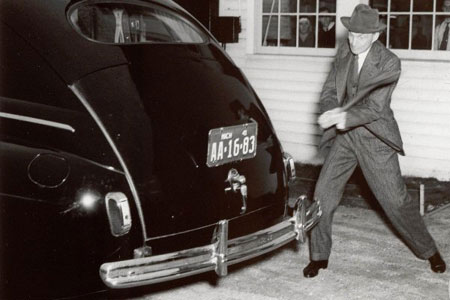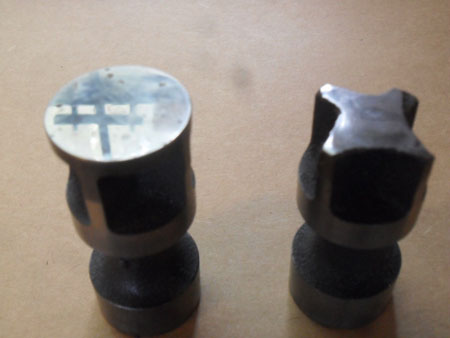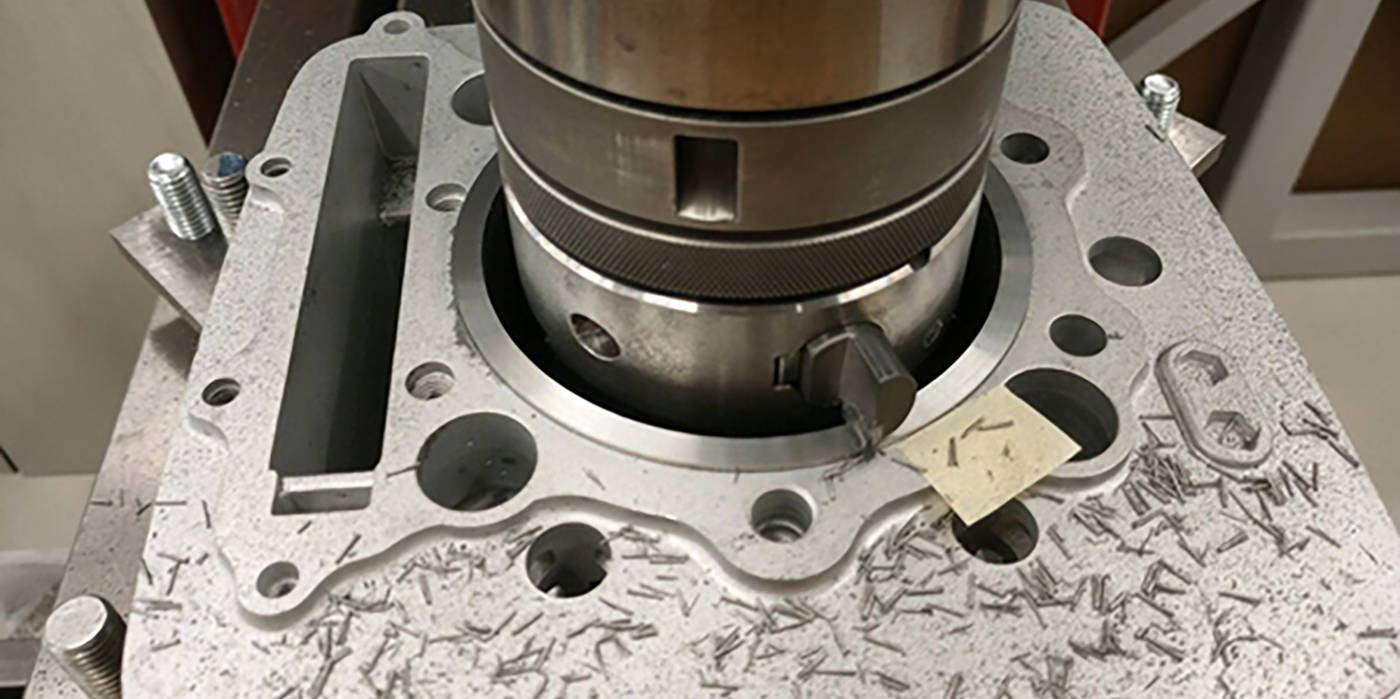Authors of Shop Solutions published in each issue of Engine Builder Magazine are awarded a prepaid $100 Visa gift card. Shop Solutions may also be submitted to [email protected].
Cylinder Sleeve Flange Failures May Go Unnoticed
Cylinder sleeve flange failures may go unnoticed if the sleeve body stays in position, but if it is pulled down the cylinder, the result can be catastrophic. Cylinder sleeves are usually made from centrifugally cast iron, which makes for good wear resistance, but they can be fractured if dropped or crushed. This usually appears as a crack running down the length of the liner.
Cracks which follow the underside of the flange are caused when fitting the sleeve to the cylinder block, or when installing the cylinder head. With care, these cracks can be avoided. Cracks that start under a sleeve flange are caused by twisting of the flange and the sleeve being pulled apart. The following are causes of and ways to avoid this type of failure.
When installing a sleeve:
• If a press is used to push the sleeve into position, a rigid plate must be placed between the press and the sleeve. If the plate bows, a bursting stress will be imposed on the cylinder sleeve.
• Care must be taken to ensure that excessive pressure is not used. This could shear off part of the sleeve flange once it has been pushed fully home into its recess.
• Be certain that the cylinder block counter bore is even, uniform in depth and parallel to the top surface of the block.
• Be certain the counter bore seat is not worn at the inner edge. If worn, it will cause the seat to tilt downward and possibly crack.
• Be certain there is not an unequal protrusion of flange height in relation to the top of the block.
When installing cylinder heads:
• Always use the correct torquing sequence. An improper sequence can result in failure.
• Do not tighten head bolts more than what is recommended. Excessive tightening can result in failure.
If lubrication is used to assist fitting the sleeve, the cylinder block should be lubricated, but not the sleeve. Otherwise, the lubricant will be scraped off the sleeve as it is pushed home. The lubricant will accumulate in the block recess and prevent the flange from seating. In time, the lubricant will dissipate and leave the flange unsupported and vulnerable to fracture. When correctly installed, a cylinder sleeve becomes an integral part of the cylinder block and can only be removed intentionally or by a severe engine malfunction.
Scott York
Advantage Engine Parts
Lynn, IN
Making Non-Hydraulic Lash Adjustments Quick, Easy
On DOHC cylinder heads that have solid or shim lash adjusters, you can speed up your adjustments by scribing each valve with a number and numbering the corresponding cup. Grinding the valve, cutting the tip and cutting the valve seat sometimes cancel each other out. Even if they don’t, you will be very close to correct adjustments just by keeping them in order. I use fishing boxes to organize the cups until I’m ready to clean and reinstall them.
Jeffrey Myers
MAR Automotive, Inc.
Philadephia, PA
Save Those Old, Failed Parts
I suggest keeping a few examples of failed parts around your machine shop so you can show a customer first hand what happens in his engine. Below is a photo of a failed lifter, a prime example and perfect chance to teach your customers the importance of break-in oils and procedures. Some other failed parts that would be valuable to hold on to and show customers are pistons with pre-ignition problems.
Kevin Elam
Kevin’s Liberty Auto Machine Shop
Liberty, MO
Fertilizer Spreader and Kitty Litter: Perfect Match
When spreading absorbent or kitty litter around your shop, pick up a hand held fertilizer spreader and keep it filled and ready. When you have a spill, just grab the spreader, give it a couple of quick spins and the problem is taken care of.
Paul Wampler
Engine & Performance Warehouse
Denver, CO
A Spectacular Method of Removing Broken or Seized Bolts
I use a direct method to remove broken and seized bolts or studs in iron or steel; a cutting torch applied directly to the stub-end. Once the stub is glowing bright red, I hit the oxygen lever and a fountain of steel erupts from the hole. Be certain to wear protective clothing!
Strangely, the female threads in the part are never damaged by this treatment. A clean up of the hole with a thread chasing tap restores the part to near-new condition without the risk of drilling off center or oversizing. This may be because there is always an air gap between even a seized bolt and whatever it is threaded in to. The air gap must insulate the female threads.
This method works particularly well on blind holes with broken exhaust manifold studs in cylinder heads or manifolds, and broken motor mount bolts in blocks.
Jack DeRyke (via email)
Factoid of the Month:
Soybeans and Automobiles: From Henry Ford to Biodiesel
In the ’30s and early ’40s Henry Ford was determined to make bodies and other car parts from soybean phenolic resin. By 1935 he was already growing 12,000 acres of soybeans. He planned to use one million bushels of soybeans per year for various automotive parts and liquids.
To prove his point, in 1941 he held a press conference where he slammed a fire axe into the body of a Ford made of soybeans, causing no apparent damage. He then rewarded the press corps with a soybean lunch, including soybean soup, soybean steak, soybean coffee, soybean milk and apple pie with a crust made from soybeans.
So what happened to Henry Ford’s soybean plans? By the time World War II was over, Henry Ford was losing control of the business, and his soybean plans were forgotten.
Today, soybeans are being used to produce biodiesel, which according to studies done by the University of Minnesota and St. Olafs College, is much more efficient to produce than corn based ethanol. The studies found that ethanol generates only 25% more energy than required for its production, where biodiesel generates 93% more energy.
One small problem. According to a study by the National Academy of Sciences, if all American corn and soybean production were dedicated to biofuels, they would only satisfy 12% of gasoline and 6% of diesel demand.
Engine Builder Shop Solutions is sponsored by Engine Pro, a group of 9 engine parts specialist WDs in the U.S., and one in Australia, operating 35 branch locations serving engine builders/rebuilders across the U.S and Australia. Authors of Shop Solutions published in each issue of Engine Builder Magazine are awarded a prepaid $100 Visa gift card. Entries will be chosen by the staff of Engine Builder Magazine and the Engine Pro Technical Committee.
To submit a Shop Solution simply mail your entry to Engine Builder Magazine, Shop Solutions, 3550 Embassy Parkway, Akron, OH 44333; or email to [email protected]. Shop Solutions may also be emailed to [email protected].
You must include your name, shop name, shop address and shop telephone number. Submitted Shop Solutions not published will be kept on file and reevaluated for publication with each month’s new entries. If you include your email address you will be emailed notification of publication if your Shop Solution is chosen.















